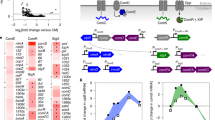Abstract
The yeastCandida albicans coaggregates with a variety of streptococcal species, an interaction that may promote oral colonization by yeast cells.C. albicans andCandida tropicalis are the yeasts most frequently isolated from the human oral cavity and our data demonstrate that both these species bind toStreptococcus gordonii NCTC 7869 while two otherCandida species (Candida krusei andCandida kefyr) do not. Adherence ofC. albicans was greatest when the yeast had been grown at 30° C to mid-exponential growth phase. For 21 strains ofC. albicans there was a positive correlation between the ability to adhere toS. gordonii and adherence to experimental salivary pellicle. Whole saliva either stimulated or slightly inhibited adherence ofC. albicans toS. gordonii depending on the streptococcal growth conditions. The results suggest that the major salivary adhesins and coaggregation adhesins ofC. albicans are co-expressed.
Similar content being viewed by others
References
Arendorf TM and DM Walker. 1980. The prevalence and intra-oral distribution ofCandida albicans in man. Arch Oral Biol 25: 1–10.
Bradway SD, EJ Bergey, FA Scannapieco, N Rama Subbu, S Zawacki and MJ Levine. 1992. Formation of salivary-mucosal pellicle: the role of transglutaminase. Biochem J 284: 557–564.
Brassart D, A Woltz, M Golliard and J-R Neeser. 1991.In vitro inhibition of adhesion ofCandida albicans clinical isolates to human buccal epithelial cells by Fucα1->2Galβ-bearing complex carbohydrates. Infect Immun 59: 1605–1613.
Burford-Mason AP, JM Willoughby and JC Weber. 1993. Association between gastrointestinal tract carriage ofCandida, blood group O, and non-secretion of blood group antigens in patients with peptic ulcer. Dig Dis Sci 38: 1453–1458.
Calderone RA, L Linehan, E Wadsworth and AL Sandberg. 1988. Identification of C3d receptors onCandida albicans. Infect Immun 56: 252–258.
Cannon RD, AK Nand and HF Jenkinson. 1995. Adherence ofCandida albicans to human salivary components adsorbed to hydroxylapatite. Microbiology 141: 213–219.
Critchley IA and LJ Douglas. 1987. Role of glycosides as epithelial cell receptors forCandida albicans. J Gen Microbiol 133: 637–643.
Edgerton M, FA Scannapieco, MS Reddy and MJ Levine. 1993. Human submandibular-sublingual saliva promotes adhesion ofCandida albicans to polymethylmethacrylate. Infect Immun 61: 2644–2652.
Fukayama M, E Wadsworth and R Calderone. 1992. Expression of the C3d-binding protein (CR2) fromCandida albicans during experimental candidiasis as measured by lymphoblastogenesis. Infect Immun 60: 8–12.
Gibbons RJ, DI Hay and DH Schlesinger. 1991. Delineation of a segment of adsorbed salivary acidic proline-rich proteins which promotes adhesion ofStreptococcus gordonii to apatitic surfaces. Infect Immun 59: 2948–2954.
Grevstad HJ and KN Leknes. 1993. Ultrastructure of plaque associated with polytetrafluoroethylene (PTFE) membranes used for guided tissue regeneration. J Clin Periodontol 20: 193–198.
Holmes AR, RD Cannon and MG Shepherd. 1991. Effect of calcium ion uptake onCandida albicans morphology. FEMS Microbiol Lett 77: 187–194.
Jenkinson HF. 1994. Cell surface protein receptors in oral streptococci. FEMS Microbiol Lett 121: 133–140.
Jenkinson HF, HC Lala and MG Shepherd. 1990. Coaggregation ofStreptococcus sanguis and other Streptococci withCandida albicans. Infect Immun 58: 1429–1436.
Kennedy MJ and RL Sandin. 1988. Influence of growth conditions onCandida albicans adhesion, hydrophobicity and cell wall ultrastructure. J Med Vet Mycol 26: 79–92.
Klotz SA, MJ Rutten, RL Smith, SR Babcock and MD Cunningham. 1993. Adherence ofCandida albicans to immobilized extracellular matrix proteins is mediated by calcium-dependent surface glycoproteins. Microb Pathogen 14: 133–147.
Lamont RJ and B Rosan. 1990. Adherence of mutans streptococci to other oral bacteria. Infect Immun 58: 1738–1743.
Odds FC, 1988. Candida and Candidosis. Baillière Tindall, London.
Powderly WG, K Robinson and EJ Keath. 1993. Molecular epidemiology of recurrent oral candidiasis in human immunodeficiency viruspositive patients: evidence for two patterns of recurrence. J Infect Dis 168: 463–466.
Stinson MW, GG Haraszthy, XL Zhang and MJ Levine. 1992. Inhibition ofPorphyromonas gingivalis adhesion toStreptococcus gordonii by human submandibular-sublingual saliva. Infect Immun 60: 2598–2604.
Tosh FD and LJ Douglas. 1992. Characterization of a fucoside-binding adhesin ofCandida albicans. Infect Immun 60: 4734–4739.
Williamson JJ. 1972. A study of extent of variation in daily counts ofCandida albicans in saliva. Aust Dent J 17: 106–109.
Author information
Authors and Affiliations
Rights and permissions
About this article
Cite this article
Holmes, A., Cannon, R. & Jenkinson, H. Interactions ofCandida albicans with bacteria and salivary molecules in oral biofilms. Journal of Industrial Microbiology 15, 208–213 (1995). https://doi.org/10.1007/BF01569827
Received:
Accepted:
Issue Date:
DOI: https://doi.org/10.1007/BF01569827




